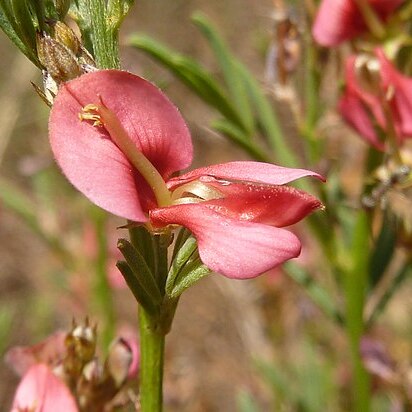Perennial, usually flowering after a fire, with a woody rootstock and several decumbent or weakly ascending stems up to 30 cm. long; everywhere sparsely appressed strigose with rather long (up to 0.9 mm.) biramous hairs; long erect glandular or eglandular multicellular hairs are usually also present on the stems and similar but shorter hairs on leaf-and inflorescence-rhachides but not on the leaflets.. Stipules narrowly attenuate, up to 4 mm. long; rhachis, including a petiole of 1–6 mm., up to 15 mm. long, usually not prolonged beyond the lateral leaflets except in 3-foliolate leaves; leaflets 3–7, oblanceolate or narrowly elliptic, stiffly acute or obtuse, up to 15 mm. long and 5 mm. wide.. Raceme 5–10-flowered, 3–5 cm. long, including a peduncle of 1–3 cm., the 2 lowest flowers usually subopposite; bracts lanceolate, up to 2 mm. long, caducous or persistent; pedicels erect, 1–2 mm. long.. Calyx strigose, ± 3 mm. long, divided for three-quarters of its length into narrowly triangular-subulate lobes.. Corolla densely appressed white strigose outside, 7–8 mm. long.. Stamens 5–7 mm. long.. Ovules 6–8.. Pod more or less erect, cylindrical, 10–14 mm. long, 1.3 mm. wide, strigose-puberulent, 4–6-seeded; endocarp spotted.
Suffrutex or subshrub, up to 0.1-0.8(1.0) m high; rootstock woody, many-stemmed, much-branched, angular, reddish brown; indumentum canescent-strigose and with patent reddish multicellular hairs up to 0.2 mm long, sometimes gland-tipped, pearl bodies on juvenile growth. Stipules 2-9 mm long, linear-setaceous. Leaves pinnate, mostly with 3-7 leaflets, rachis 2-15(25) mm long; petioles 0.5-4.0 mm long. Terminal leaflet (5)6-16(25) x 1-5(6) mm, oblanceolate to oblong-elliptic, apex acute; sparsely to densely appressed to spreading strigose above, more coarsely strigose below. Inflorescences of 10-40(50) mm long, ± densely (4)5-12(15)-flowered racemes; peduncle 3-10(17) mm long; pedicels (0.5)1.0-3.5 mm long. Flowers 7-9 mm long, rose-pink to deep carmine-red; calyx (3.5)4.0-5.0(6.0) mm long, grey strigillose; lobes narrowly triangular; standard dorsally appressed strigillose, keel apex obtuse. Stamens (5.5)6.0-7.0(8.0) mm long. Flowering time July-Jan. Pod (10)12-30 x 2 mm.
A shrub. It has a woody rootstock. The stems are short and tufted. They are flattened and angular. The leaves are crowded. The leaves can have 1-4 divisions. The leaflets are oblong to sword shaped. The flowers are purple to crimson. The pod is 10-14 mm long by 1.3 mm wide. There are 4-6 seeds.

